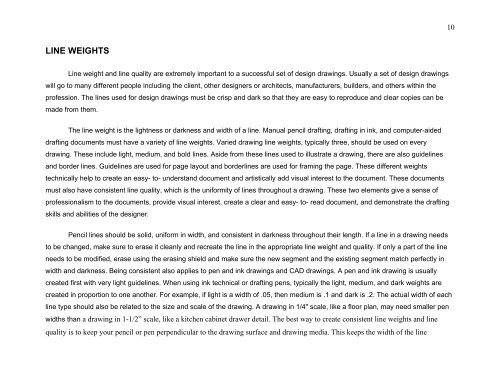Basic Drafting Standards - Interior Design - University of Minnesota
Basic Drafting Standards - Interior Design - University of Minnesota
Basic Drafting Standards - Interior Design - University of Minnesota
Create successful ePaper yourself
Turn your PDF publications into a flip-book with our unique Google optimized e-Paper software.
LINE WEIGHTS<br />
Line weight and line quality are extremely important to a successful set <strong>of</strong> design drawings. Usually a set <strong>of</strong> design drawings<br />
will go to many different people including the client, other designers or architects, manufacturers, builders, and others within the<br />
pr<strong>of</strong>ession. The lines used for design drawings must be crisp and dark so that they are easy to reproduce and clear copies can be<br />
made from them.<br />
The line weight is the lightness or darkness and width <strong>of</strong> a line. Manual pencil drafting, drafting in ink, and computer-aided<br />
drafting documents must have a variety <strong>of</strong> line weights. Varied drawing line weights, typically three, should be used on every<br />
drawing. These include light, medium, and bold lines. Aside from these lines used to illustrate a drawing, there are also guidelines<br />
and border lines. Guidelines are used for page layout and borderlines are used for framing the page. These different weights<br />
technically help to create an easy- to- understand document and artistically add visual interest to the document. These documents<br />
must also have consistent line quality, which is the uniformity <strong>of</strong> lines throughout a drawing. These two elements give a sense <strong>of</strong><br />
pr<strong>of</strong>essionalism to the documents, provide visual interest, create a clear and easy- to- read document, and demonstrate the drafting<br />
skills and abilities <strong>of</strong> the designer.<br />
Pencil lines should be solid, uniform in width, and consistent in darkness throughout their length. If a line in a drawing needs<br />
to be changed, make sure to erase it cleanly and recreate the line in the appropriate line weight and quality. If only a part <strong>of</strong> the line<br />
needs to be modified, erase using the erasing shield and make sure the new segment and the existing segment match perfectly in<br />
width and darkness. Being consistent also applies to pen and ink drawings and CAD drawings. A pen and ink drawing is usually<br />
created first with very light guidelines. When using ink technical or drafting pens, typically the light, medium, and dark weights are<br />
created in proportion to one another. For example, if light is a width <strong>of</strong> .05, then medium is .1 and dark is .2. The actual width <strong>of</strong> each<br />
line type should also be related to the size and scale <strong>of</strong> the drawing. A drawing in 1/4" scale, like a floor plan, may need smaller pen<br />
widths than a drawing in 1-1/2” scale, like a kitchen cabinet drawer detail. The best way to create consistent line weights and line<br />
quality is to keep your pencil or pen perpendicular to the drawing surface and drawing media. This keeps the width <strong>of</strong> the line<br />
10


